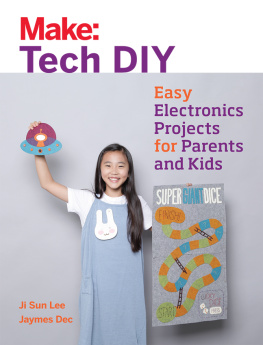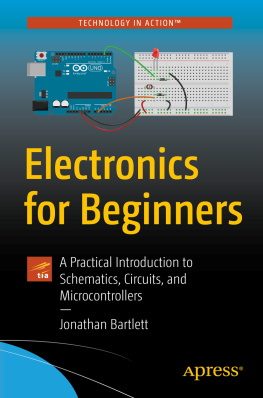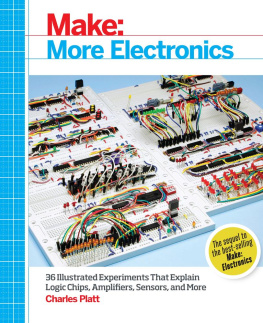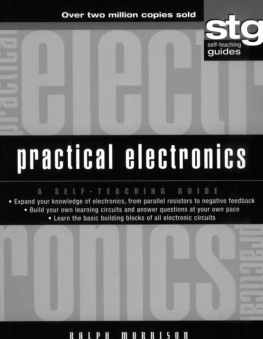Contents in Detail
ELECTRONICS FOR KIDS
PLAY WITH SIMPLE CIRCUITS AND EXPERIMENT WITH ELECTRICITY!
YVIND NYDAL DAHL
San Francisco
ELECTRONICS FOR KIDS. Copyright 2016 by yvind Nydal Dahl.
All rights reserved. No part of this work may be reproduced or transmitted in any form or by any means, electronic or mechanical, including photocopying, recording, or by any information storage or retrieval system, without the prior written permission of the copyright owner and the publisher.
Printed in Canada
First printing
20 19 18 17 16 1 2 3 4 5 6 7 8 9
ISBN-10: 1-59327-725-3
ISBN-13: 978-1-59327-725-3
Publisher: William Pollock
Production Editor: Riley Hoffman
Cover Illustration: Garry Booth
Interior Design: Beth Middleworth
Developmental Editor: Jennifer Griffith-Delgado
Technical Reviewer: John Hewes
Copyeditor: Julianne Jigour
Compositor: Riley Hoffman
Proofreader: Paula L. Fleming
For information on distribution, translations, or bulk sales, please contact No Starch Press, Inc. directly:
No Starch Press, Inc.
245 8th Street, San Francisco, CA 94103
phone: 415.863.9900;
www.nostarch.com
Library of Congress Cataloging-in-Publication Data
Names: Nydal Dahl, yvind, author.
Title: Electronics for kids : play with simple circuits and experiment with
electricity! / by yvind Nydal Dahl.
Description: San Francisco : No Starch Press, [2016] | Audience: Ages 10+ |
Includes index.
Identifiers: LCCN 2015048986 (print) | LCCN 2016005706 (ebook) | ISBN
9781593277253 (pbk.) | ISBN 1593277253 (pbk.) | ISBN 9781593277475 (epub)
| ISBN 1593277474 (epub) | ISBN 9781593277482 (mobi) | ISBN 1593277482
(mobi)
Subjects: LCSH: Electronics--Juvenile literature. | Electronic
circuits--Juvenile literature.
Classification: LCC TK7820 .N93 2016 (print) | LCC TK7820 (ebook) | DDC
621.381--dc23
LC record available at http://lccn.loc.gov/2015048986
No Starch Press and the No Starch Press logo are registered trademarks of No Starch Press, Inc. Other product and company names mentioned herein may be the trademarks of their respective owners. Rather than use a trademark symbol with every occurrence of a trademarked name, we are using the names only in an editorial fashion and to the benefit of the trademark owner, with no intention of infringement of the trademark.
The information in this book is distributed on an As Is basis, without warranty. While every precaution has been taken in the preparation of this work, neither the author nor No Starch Press, Inc. shall have any liability to any person or entity with respect to any loss or damage caused or alleged to be caused directly or indirectly by the information contained in it.
ABOUT THE AUTHOR
yvind Nydal Dahl has been an electronics enthusiast since he was a kidhes always loved figuring out how things worked so he could try to build them for himself. He studied electronics and computer science at the University of Oslo, where he received a masters degree after building his own microchip. He then co-founded the company Intelligent Agent to develop sensors that allow robots to see through walls.
After a few years at Intelligent Agent, yvind set out on a mission to teach the world electronics. He gives workshops, develops courses, and writes about electronics and technology for a variety of outlets. Hes posted hundreds of articles, tutorials, and videos on his blog (http://www.build-electronic-circuits.com/) and maintains Ohmify (http://ohmify.com/), a membership site that makes learning electronics fun and easy.
ABOUT THE TECHNICAL REVIEWER
John Hewes began connecting electrical circuits at an early age, moving on to electronics projects as a teenager. He later earned a physics degree and continued to develop his interest in electronics, helping school students with their projects while working as a science technician.
John has taught electronics and physics up to an advanced level in the United Kingdom and ran a school electronics club for children aged 11 to 18 years, setting up the website http://www.electronicsclub.info/ to support the club. He believes that everyone can enjoy building electronics projects, regardless of their age or ability.
CONTENTS IN DETAIL
WHAT IS ELECTRICITY?
MAKING THINGS MOVE WITH ELECTRICITY AND MAGNETS
HOW TO GENERATE ELECTRICITY
CREATING LIGHT WITH LEDS
BLINKING A LIGHT FOR THE FIRST TIME
LETS SOLDER!
CONTROLLING THINGS WITH ELECTRICITY
BUILDING A MUSICAL INSTRUMENT
HOW CIRCUITS UNDERSTAND ONES AND ZEROS
CIRCUITS THAT MAKE CHOICES
CIRCUITS THAT REMEMBER INFORMATION
LETS MAKE A GAME!
FOREWORD
Theres something special about bringing a project to life that you read about in a book or that started as an idea in your head. And sometimes the simplest things are the most satisfying.
One of my favorite childhood projects was a mischievous little device made of a single resistor connected between the tip and ring of a telephone line. I used a piece of one-sided copper circuit board with rub-off symbols to lay out the design, and then I etched the unprotected copper away using ferric chloride in my basement. You could still use the phone normally to make outgoing calls, but anyone calling the house would receive a busy signal. This was the perfect way to make sure my parents didnt receive any phone calls from my teachers during dinner!
A few years later, I modified a garage door opener to open any door of the same brand. In normal operation, the passwords on the transmitter and receiver were manually set with a series of 10 DIP switches. If the transmission signal matched what the receiver was expecting, then the garage door would open. I replaced the switches on my transmitter with a common 555 timer IC, to generate a clock signal, and a 10-stage binary counter, a type of digital logic device, to automatically try every single possible combination (thats 210 or 1,024 attempts). Within a few minutes of holding down the button, the correct password would be transmitted and the garage door would open! I never used my universal brute-force garage door opener for malicious purposes, but it reinforced my hacker mindsetsolving problems with unconventional solutions, pushing the limits of technology, harming no one, and learning through constant questioning and experimentation. I also thought it was pretty cool to be able to modify an off-the-shelf device and make it do something the original designers probably never anticipated.
When I was much younger, I somehow ended up with a 6 V lantern battery and a spring from an adjustable lamp. I wondered, What would happen if I connected the spring between the battery terminals? So of course, I tried it. The spring got hotter and hotter until I freaked out, plucked it off the terminals, and threw it into the bathroom sink. I had created a short circuit by connecting the positive and negative terminals of the battery together, causing current to flow between them. I never looked at batteries and springs the same way again.











